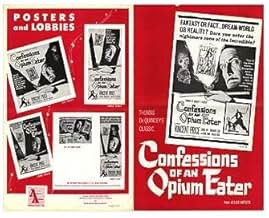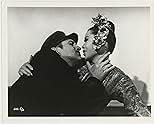Adicionar um enredo no seu idiomaIn 19th-century San Francisco's Chinatown, American adventurer Gilbert De Quincey saves slave girls owned by the Chinese Tong factions.In 19th-century San Francisco's Chinatown, American adventurer Gilbert De Quincey saves slave girls owned by the Chinese Tong factions.In 19th-century San Francisco's Chinatown, American adventurer Gilbert De Quincey saves slave girls owned by the Chinese Tong factions.
- Direção
- Roteiristas
- Artistas
- Lotus
- (as June Kim)
- Lo Tsen
- (as Caroline Kido)
- First Dancing Girl
- (as Joanne Miya)
- Auctionieer
- (as John Mamo)
- Direção
- Roteiristas
- Elenco e equipe completos
- Produção, bilheteria e muito mais no IMDbPro
Avaliações em destaque
Ah, 1962. Producer/director Albert Zugsmith evidently met his Muse and cranked out this gleefully un-PC look at the Yellow Peril in San Francisco 1902. Zugsmith, despite some legitimate credits on his resume, wallowed in exploitation for the most part. COAOE somehow escaped Zugsmith's penchant for low-level production and rose above what should have been a Z-list production. What resulted was a real oddity, a bastardized version of Thomas De Quincey's late 1800s drug tale. This movie bears little resemblance to De Quincey's fable. The screenplay is more Sax Rohmer/Fu Manchu than anything else.
This drive-in classic has it all folks. Enigmatic fortune cookie wisdom, secret passages out the yin-yang, a sultry Dragon Lady named Ruby with world domination on her mind, a wisecracking Chinese Munchkin sing-song girl, Polynesian twerking, firecrackers, Tong warfare, every Chinese actor in Hollywood, Vincent Price as a moody poetic sort of action hero...and yes, opium. Price's opium dream is a real hoot for fans of late 1950s Allied Artists horror/sci-fi flicks. After nodding off on the pipe, Vinny gets visited by a host of critters from other AA pics in short cameo appearances. He sees the "eyeball hand" from Invasion of the Saucermen, crawling along. He sees the monster tarantula from The Spider. He sees the "voodoo woman" from Voodoo Woman. He sees the skull from Screaming Skull. Also lots of Chinese masks and fish-eye lens howling people. Zugsmith really raided the AA vaults to put this trip together.
The famous slo-mo scene, done in complete silence, is still pretty effective. It's surreal, dreamy, and unexpected. Also of note is the "girl auction" in which captive gals from the United Nations perform native dances for the Mandarin crowd and their impressive wisdom hats. Watch for Miss Polynesia, who really does twerk, in addition to writhing around to a soundtrack that switches from ersatz Chinese to SF North Beach beatnik coffee bar free form jazz. Tasty!
Well worth seeking out if you've heard about this. It's short and to the point. Also extremely weird. The ending is unexpected. Over fifty years later, a movie like this could not be made. There are racial stereotypes presented in an unapologetic manner, strictly due to the time in which it was made.
Anyway, how can you resist a movie that owns the line: "NO! Use the velvet whips, they don't mar the body!" Delicious.
Nominally based on Thomas De Quincy's CONFESSIONS OF AN ENGLISH OPIUM EATER, it seems a mildly incoherent, sloppily composed movie. On the other hand, there is the implication that this is all an opium dream, which would go a ways towards explaining the lack of sense. Given that the producer-director, Albert Zugsmith, was a hard-working man who had produced movies like Orson Welles' TOUCH OF EVIL and directed SAPPHO DARLIng, I'll come down in the middle. I think he intended this to be an opium dream, but given the script by Robert Hill, the remnants of the Production Code, and his own less than stellar talents, it's not a great success. Still, it provides a chance to see a lot of Studio Era actors like ichard Loo, Phillip Ahn, and Victor Sen Yung.
Some years ago I had read Thomas DeQuincey's literary classic "Confessions Of An English Opium Eater" (for the record, Dario Argento's SUSPIRIA {1977} derives its title from the author's "Suspiria De Profundis") – along with Aleister Crowley's "Diary Of A Drug Fiend" (another such book I acquired but which I have yet to go through is Aldous Huxley's "The Doors Of Perception") – while preparing to embark on my third screenplay but its semi-autobiographical fantasia nature has, so far, largely proved hard to pin down! Having said that, despite the fact that Vincent Price's central character in the movie was named Gilbert DeQuincey and it does feature a series of hallucinatory sequences, the film under review is no adaptation of the book. For one thing, it is set in San Francisco against the original's London and, as if to emphasize that difference, it was distributed also under the alternative monikers of SOULS FOR SALE (which is the title sported by the thankfully good-looking TV print I watched that does justice to Eugene Lourie''s remarkable production design - after an earlier one I had come by proved very fuzzy!) and EVILS OF CHINATOWN. For what it is worth, the film is said to have inspired John Carpenter's BIG TROUBLE IN LITTLE CHINA (1986), a guilty pleasure from my childhood days!
Actually, this is the first example I have watched from Zugsmith's tawdry directorial efforts and, by all accounts, it is the only one worth seeing. Conversely, his credits as producer were pretty impressive and versatile: Douglas Sirk's WRITTEN ON THE WIND (1956) and THE TARNISHED ANGELS (1957); a clutch of Jack Arnold films, including his best i.e. THE INCREDIBLE SHRINKING MAN (1957); and, finally, Orson Welles' TOUCH OF EVIL (1958) which, given its drug-addiction subplot, is the most pertinent to CONFESSIONS. Discriminating viewers might well find this one of the most inept things they had ever witnessed but, for those able to accept its uniqueness, the sheer oddity on display exerts an undeniable fascination. Right from the opening sequence showing a horse galloping on a deserted beach, followed by a curiously silent pirate crew manhandling their captive female cargo around (sometimes being literally thrown overboard into a descending net and falling, comically speeded-up, into place and in unison on a waiting barge!) and, when a scuffle erupts on the beach between Tong factions, the horse makes a sudden reappearance to save one of the girls (who later has an active part in the narrative) by pushing her assailant off of a cliff! The 'abduction of women for pleasure' theme links this to Price's later vehicle, the Harry Alan Towers production HOUSE OF A THOUSAND DOLLS (1967; where the star's role was more ambiguous yet less adventurous than here), a viewing of which actually preceded this one!
The hallucination sequences are truly weird here, with a proliferation of predictably nightmarish images and slow-motion chases that are suddenly speeded-up, like Price's fall from a rooftop; incidentally, it is a rare sight to have Vincent Price as the action hero but, then, the entire film feels like it did not belong in the early 1960s! The underground slave trading sequence is one of the most striking in the film, even if this includes a succession of protracted dance routines that are meant to show off the attractive qualities of the 'merchandise' on display to the gathering of prospective buyers! Price, who is forever spouting poetically-defiant lines at his captors (even while embarrassingly hanging off-the-ground on a meat-hook!), finds an improbable ally in a spirited female midget who eventually gets a knife in the back just as they are about to make their escape down a manhole. Curiously enough for a movie of which he is the intermittent narrator, Price himself is presumed dead at the very end as he and the villainess (the actress playing her bears the unfortunately appropriate name of Linda Ho!) are whisked away by the flowing underground currents.
Você sabia?
- CuriosidadesIndirectly led to the creation of the famed East West Players. Many of the Asian actors, including a young James Hong, were incensed after the only roles they were offered were "opium dope people and the prostitutes and so forth." After a petition to producer Albert Zugsmith fell on deaf ears, Hong co-founded the East West Players to give Asian-American actors more meaningful, non-stereotypical roles.
- Erros de gravaçãoThis film takes place in the 19th century, as stated, and seen in the townspeople's dress. But in the beach scene, a Thompson machine gun is used; this wasn't available until after 1918.
- Citações
Gilbert De Quincey: [narration] When the dreams of the dark, idle, monstrous phenomenae move forever forward... wild, barbarous, capricious into the great yawning darkness... to be fixed for centuries in secret rooms. De Quincey, the artist? De Quincey, the pagan priest, to be worshipped, to be sacrificed. What is a dream and what is reality? Sometimes a man's life can be a nightmare; other times, cannot a nightmare be life? And the voices that I heard, were they the voices of some strange imitation of men in some strange, writhing jungle of my imagination? Was this opium or was it reality? Was I dead? Or I was I only beginning to live?
- ConexõesEdited from Voodoo Woman (1957)
Principais escolhas
- How long is Confessions of an Opium Eater?Fornecido pela Alexa
Detalhes
- Tempo de duração1 hora 25 minutos
- Cor
- Proporção
- 1.37 : 1
Contribua para esta página































